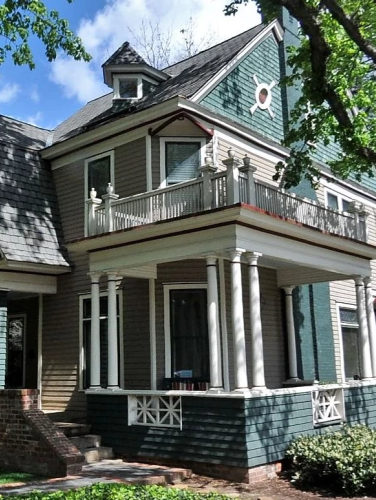
Robert J. Walker House
(ca. 1901)
The Robert J. Walker House is one of only two surviving Queen Anne style houses in Dilworth that were designed by noted local architect C. C. Hook.
329 E Park Ave, Charlotte, NC 28203
Robert Jefferson Walker (1870-1923) and his wife Mattie Charlton Walker (1876-1967) moved into their new home in Dilworth in November 1901. A native of Macon, Mississippi, Robert worked as a regional representative for the Berlin Aniline Works, a German firm that produced dyestuffs primarily for use with textile products. Married in 1897, Robert and Mattie (and later, their first two children) had been living as boarders with the Zeay Crater family at 316 North Brevard Street prior to their move into the Walkers’ own home on East Park Avenue. The couple ultimately raised six children – three girls and three boys.
Property Quick Links
The Walkers’ new home was one of several Dilworth houses designed by Charles Christian Hook (1870-1938) who, upon being hired by the Charlotte Consolidated Construction Company (known as the 4 C’s) – the local developer primarily responsible for creating the Dilworth suburb – became the first professional architect to live in Charlotte. Despite several examples of Hook’s architectural skills throughout Dilworth, the Walker House is one of only two extant Queen Anne style houses in Dilworth designed by Hook. The other is the Mallonee-Jones House (1895) at 400 East Kingston Avenue.
Hook, a graduate of Washington University in St. Louis, moved to Charlotte in 1891 to teach mechanical drawing in the Charlotte Graded School. He began working for the 4 C’s within one year of his arrival. Hook is credited with introducing the Colonial Revival style into Charlotte’s built environment. Over his career, Hook designed some 800 to 1,000 homes and buildings across the Carolinas, including Charlotte’s U.S. Post Office and Courthouse, Charlotte City Hall, the Carolina Theater, three local fire stations, and several buildings on college campuses across North Carolina (including the Chapel Hill and Greensboro campuses of the University of North Carolina, Davidson College, and N.C. State, Duke, and Queens Universities).
After the outbreak of World War I, Robert continued his association with the dyestuffs industry as a representative for the Atlantic Dyestuffs Company. He later became president of the Charlotte Knitting Company. Robert was active in the local community, serving on the board of directors for both St. Peters Hospital and the Thompson Orphanage. A longtime member and vestryman at Holy Comforter Episcopal Church in Dilworth, Robert was also an active member of the Masons and Shriners. Mattie was a native of Savannah, Georgia. Although she spent much of her time raising the couple’s six children, Mattie was also a charter member of Holy Comforter Episcopal Church and an active participant in the Daughters of the American Revolution. Mattie continued to live in the Walker House for several years following Robert’s death. After an extended illness, she died in the Wesley Nursing Center in Charlotte in 1967.
Mary Belle Niven Lowry (1897-1982) purchased the Walker House in 1944, where she resided until selling the residence in 1972 to Kenneth Daniel Williams, Jr., and his wife, Helen C. Williams. An architect by training, Kenneth actively participated in the meticulous restoration of the Walker House. The house has since continued as a private residence.

